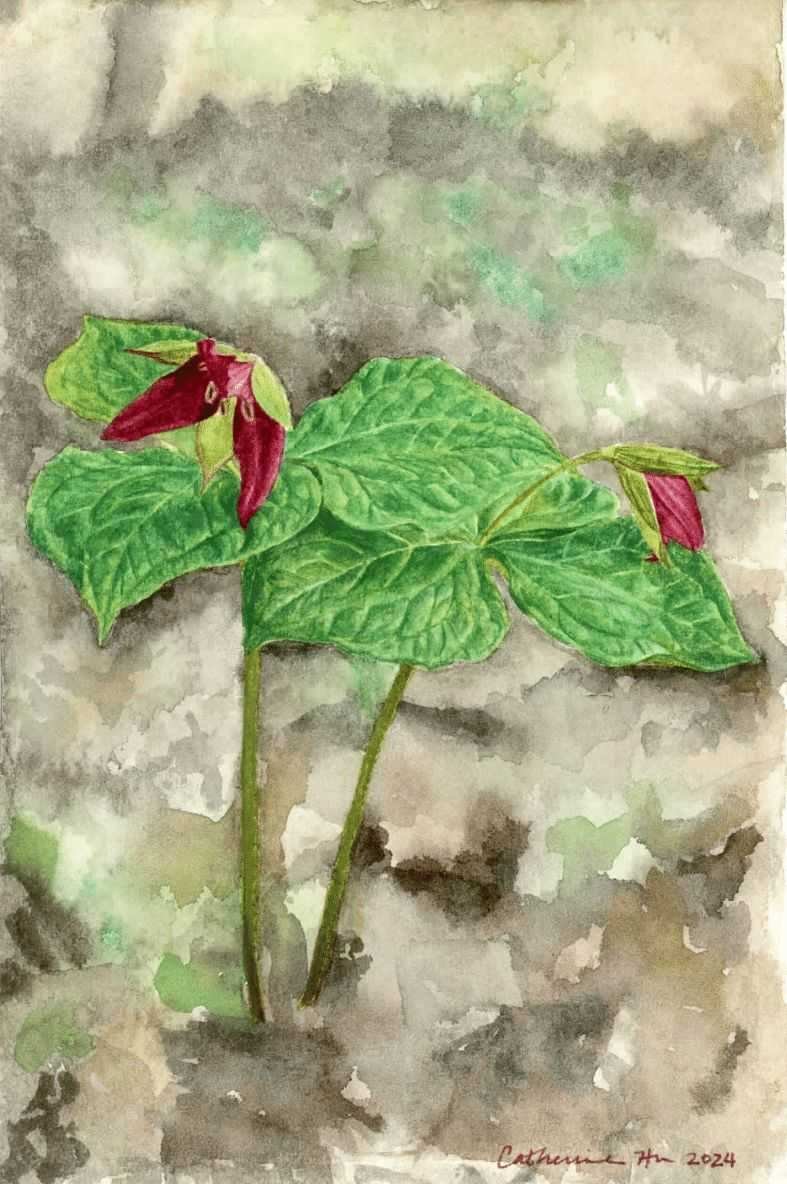Plants

Trillium erectum, red trillium.

Little bluestem (Schizachyrium scoparium) is one of the most important grasses in prairies and scarlet paintbrush (Castilleja coccinea) puts on a stunning display of color in the spring. Paintbrushes are hemiparasites, meaning they can make their own food through photosynthesis but do better when they can steal some nutrients from a host. The host plant does not die, but its ability to dominate in its environment is reduced. Reference photos by iNaturalist (lizzyvann, jaysolanki1, prairie_rambler, annikaml, lizrebstad), vPlants, Arieh Tal (GoBotany), Prairie Moon Nursery.

Dicentra cucullaria, Dutchman's breeches, is a cute little spring ephemeral. Queen bumblebees (Bombus spp.) are the primary pollinators of this plant. The flowers, which look like upside down pants, bloom early spring, coinciding with the time queen bumblebees are actively looking for pollen and nectar. Pollinators must be strong enough to pry open the flower to get to the pollen, and these queen bees are able to do it! Reference photos by Doug McGrady, MDC, Missouriplants.com, Paul Rothrock, Ozark Bill, and me.

Hamamelis vernalis, Ozark witch hazel, is a shrub native to south central US that blooms in late winter. The ribbon like petals are a welcome sight on a snowy February day. Though it's a chilly time for us humans, gnats, midges, flower flies, and other flies awaken to pollinate their fragrant flowers. There is another similar species, Hamamelis virginiana, that blooms in the fall. Reference photos by David J. Stang, Plant Image Library, Kurt Stüber.
Carex pensylvanica, common oak sedge, is an important species in dry mesic and dry woodlands and is a main fuel species. It is clump forming, spreads by rhizomes, and grows about 8 in. tall. Sedges are extremely important for ants. According to Flora of Chicago (Wilhem & Rericha), many ant species nest in their root zones and some disperse their seed. The amount of Carex pensylvanica in an area has been correlated with the diversity and density of native ant species. The dense root zone has consistent soil moisture, meaning stable soil temperature, which is important for ants. Formica subsericea is a larger ant, making it capable of carrying seed around. The seed has an elaiosome, a nutritious fatty appendage, that is eaten by the ant, and in return, the plant gets its seed moved around. This is called myrmecochory! This ant is identified by its pubescence (hairs), silky sheen, and the shape of its petiole (the part that attaches thorax to abdomen).
Polygonatum biflorum, Smooth Solomon's Seal, is a beautiful plant that arches gracefully with flowers dangling along its stem. This painting shows the stages of its life cycle: poking out of the ground in spring, flower buds, flowers in bloom, unripe fruit (green), ripe fruit (blue), full grown plant, and roots. The scars on its rhizomes are said to look like King Solomon's Hebrew seal, which is where it gets its name. Reference photos by Kevin Kenny, Melissa McMasters, Eric Hunt, Missouriplants.com, James Steakley, and me.
Asclepias tuberosa, butterfly milkweed, has bright orange, sometimes red flowers. Unlike other milkweeds (Asclepias spp.), it does not contain milky sap. Reference photos by Derek Ramsey, USGS Bee Inventory and Monitoring Lab, USFWS, Susan Strine, Leonardo DaSilva.
Passiflora incarnata, purple passionflower, is a wild looking plant native to the lower midwest and southeast. It produces an edible fruit and is usually pollinated by carpenter bees. Reference photos by Dr. Raju Kasambe, 阿橋 HQ, Density, H. Zell, USFWS Southeast Region (Wikimedia Commons).
Adiantum pedatum, maidenhair fern, is a lovely delicate woodland plant. One of my favorite plants! It can form large colonies over time and is often found in moist and shady spots. Reference photos by Ashley Basil, Tim McCormack.
Delphinium tricorne, dwarf larkspur, is a beautiful spring ephemeral. This painting shows the variation in leaf shape and flower color. Its fruits are three-parted and point upward, earning the name “tricorne,” meaning three-horned.
Silene regia, royal catchfly. The name catchfly comes from the sticky hairs on the stem and tubular part of the flower where insects often get stuck. It blooms mid-summer and is one of a few red native flowers.
Campanula americana, American bellflower. This painting shows its protandrous flowers. This means that they all start as male. Once the pollinator has visited and removed the pollen, it becomes female, meaning the stigma lobes open up to collect pollen. What a cool strategy to avoid self-pollination and increase genetic diversity!
Michigan lily, Lilium michiganense, is a true lily found in higher quality natural areas. Hummingbirds and butterflies often visit these flowers.









